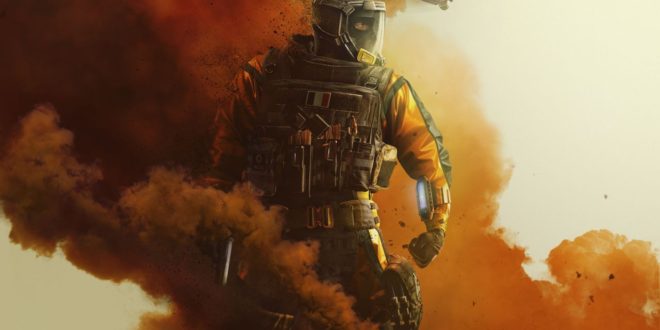Rainbow Six Siege’s game director Alexandre Remy smiles as he steps out in front of the crowd at the Six Invitational in Montreal.
It’s not hard to draw a parallel between the size of this event – the annual world championship for Siege, a celebration of the game, that brings press, influencers and fans together for one big meetup – and the title’s own success.
Rainbow Six Siege is becoming one of the biggest shooters in the world. It feels like redemption, as it launched not with the (flash)bang you might associate with a squad of aggressive counter-terrorists but with a whimper.
Launching on December 1st 2016, it had no marketing in Europe due to a recent terrorist attack. It charted at No.6 in the UK, losing sales after being caught in the deluge of Black Friday deals. Critical response for the game saw it getting mostly sevens and eights, but there wasn’t a lot of hype. General consensus was that the game was decent, but it didn’t set the world alight.
Remy nods and shakes hands with a few people he recognises, and he’s clearly ecstatic to be there. After all, it’s not just that there’s several times more people in the room than last year’s press conference, or that the arena hosting the Invitational is bigger and has a poutine truck outside (from which this writer ate poutine four times during a five day trip). It’s not even that he’s there to announce the third year of post-game content.
It’s the data. More people are playing Rainbow Six Siege than ever before. There are over 27m people with Siege across PS4, Xbox One and PC, while Ubisoft claims over 2m people are logging in every single day.
This success is likely to continue, and this year looks set to be the biggest yet for the multiplayer shooter, but that’s no surprise. Siege is a games-as-a-service success story, with Ubisoft Montreal determined not only to support players who eagerly buy each new pack, but also its non-paying customers, with most things in the game available for free or purchasable with in-game currency.
Although the game is paid for, and still retailing for £15 in most places, Ubisoft Montreal seems to have taken cues from free-to-play development: provide plenty of reason for those who don’t want to pay more to keep playing, and they’ll be on your servers waiting to get shot by players who are happy to spend serious cash. Siege caters for players who want to spend money, too. The yearly Season Pass offers early access to new operators and exclusive visual add-ons, but there is also a store full of cosmetic items that can be purchased with real money or in-game cash, and ‘elite skins’, special redesigns of operators, that can only be bought for cash. It’s an extensive system, but doesn’t feel predatory.
This year will see a third successive Season Pass, but all players will also get a cooperative campaign, Outbreak, featuring Rainbow’s special forces operators taking out extraterrestrial zombies, and a handful of new operators. This year will also see several new maps and buffs that will be small reworks and should improve the flow of a map. In addition, the very first Siege map to be designed, Hereford, is getting a full rework. The concept is fine, but the team think they can make it better.
Ubisoft Montreal’s post-launch development on Rainbow Six Siege is often reflective. The studio looks closely at what’s gone before, and isn’t shy of going back in and reworking things that don’t work. In Year Two, the studio delayed a content update to focus on Operation Health, which saw the team put the brakes on and work to fix some of the issues that had arisen during the game’s first year. It was a statement of intent: Siege was here to stay, and for that to happen, it needed to be built to last.
In many ways, Siege’s development has more in common with an MMORPG than an FPS when it comes to the way the game is developed. Regular content updates keep players invested, while a constant thrum of new content in the form of challenges, cosmetic items, fixes and balance shifts keeping the game fresh and interesting.
While many big titles shy away from huge changes, preferring instead to fix them with the next sequel, Siege has gotten involved quickly, tackling issues head on.
Balance issues with nitro cells saw them replaced with a new item, impact grenades. This allows players to keep using explosives to open up potential flanking routes without them turning into the godless killing machines from the nitro cells meta.
Siege as a game now isn’t the Siege that launched. There are new operators, sure, but the actual core experience of playing the game is now different. Siege is the promise of games-as-a-service writ large. It presents a world without yearly sequels, wholly unnecessary microtransactions (although there are some microtransactions, it never felt like players are being gouged) and a community that’s growing with each successful update.
The third year looks set to continue the trend. The new operators bring new and powerful global abilities that will shake up the game’s competitive meta, while the new cooperative mode seeks to bring some lore to Rainbow Six Siege, adding personality to characters even while they shoot the dissonant zombies that seem to have snuck in.
With Ubisoft Montreal now unveiling a two-year esports plan to take us through to 2020, a fourth year of content is practically assured, too. No game can truly live forever, but Siege seems like it has plenty left in it, and with each update it’s becoming a stranger and more interesting game.

 MCV/DEVELOP News, events, research and jobs from the games industry
MCV/DEVELOP News, events, research and jobs from the games industry




